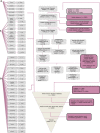What can we learn from β-cell failure biomarker application in diabetes in childhood? A systematic review
- PMID: 34512897
- PMCID: PMC8394223
- DOI: 10.4239/wjd.v12.i8.1325
What can we learn from β-cell failure biomarker application in diabetes in childhood? A systematic review
Abstract
Background: The prevalence of diabetes as a catastrophic disease in childhood is growing in the world. The search for novel biomarkers of β-cell failure has been an elusive task because it requires several clinical and biochemical measurements in order to integrate the risk of metabolic syndrome.
Aim: To determine which biomarkers are currently used to identify β-cell failure among children and adolescents with high risk factors for diabetes mellitus.
Methods: This systematic review was carried out using a modified version of the PICO protocol (Participants/Intervention/Comparison/Outcome). Once our research question was established, terms were individually researched on three different databases (PubMed, BIREME and Web of Science). The total articles obtained underwent a selection process from which the 78 most relevant articles were retrieved to undergo further analysis. They were assessed individually according to quality criteria.
Results: First, we made the classification of the β-cell-failure biomarkers by the target tissue and the evolution of the disease, separating the biomarkers in relation to the types of diabetes. Second, we demonstrated that most biomarkers currently used as early signs of β-cell failure are those that concern local or systemic inflammation processes and oxidative stress as well as those related to endothelial dysfunction processes. Third, we explored the novelties of diabetes as a protein conformational disease and the novel biomarker called real human islet amyloid polypeptide amyloid oligomers. Finally, we ended with a discussion about the best practice of validation and individual control of using different types of biomarkers in type 1 and type 2 diabetes in order to assess the role they play in the progress of diabetes in childhood.
Conclusion: This review makes widely evident that most biomarkers currently used as early signs of β-cell failure are those that concern local or systemic inflammation processes and oxidative stress as well as those related to endothelial dysfunction processes. Landing in the clinical practice we propose that real human islet amyloid polypeptide amyloid oligomers is good for identifying patients with β-cell damage and potentially could substitute many biomarkers.
Keywords: Adolescents; Biomarker; Children; Diabetes mellitus; Metabolic syndrome; β-cell failure.
©The Author(s) 2021. Published by Baishideng Publishing Group Inc. All rights reserved.
Conflict of interest statement
Conflict-of-interest statement: The authors have declared that no competing interest exist.
Figures



Similar articles
-
The Effectiveness of Integrated Care Pathways for Adults and Children in Health Care Settings: A Systematic Review.JBI Libr Syst Rev. 2009;7(3):80-129. doi: 10.11124/01938924-200907030-00001. JBI Libr Syst Rev. 2009. PMID: 27820426
-
Measurement of Pro-Islet Amyloid Polypeptide (1-48) in Diabetes and Islet Transplants.J Clin Endocrinol Metab. 2017 Jul 1;102(7):2595-2603. doi: 10.1210/jc.2016-2773. J Clin Endocrinol Metab. 2017. PMID: 28368485
-
Psychological interventions to improve self-management of type 1 and type 2 diabetes: a systematic review.Health Technol Assess. 2020 Jun;24(28):1-232. doi: 10.3310/hta24280. Health Technol Assess. 2020. PMID: 32568666 Free PMC article.
-
Association between pacifier use and breast-feeding, sudden infant death syndrome, infection and dental malocclusion.JBI Libr Syst Rev. 2005;3(6):1-33. doi: 10.11124/01938924-200503060-00001. JBI Libr Syst Rev. 2005. PMID: 27819973
-
Type 2 diabetes mellitus as a conformational disease.JOP. 2005 Jul 8;6(4):287-302. JOP. 2005. PMID: 16006679 Review.
References
LinkOut - more resources
Full Text Sources

